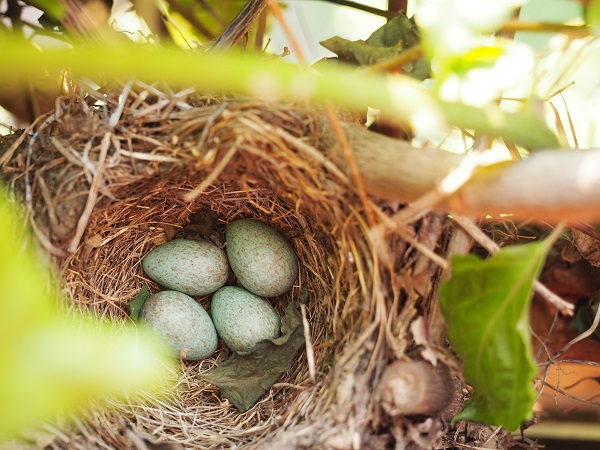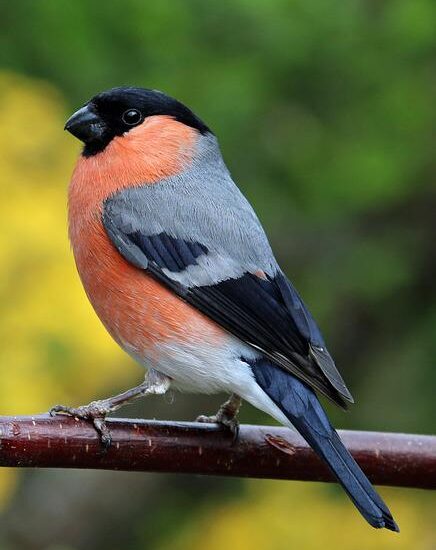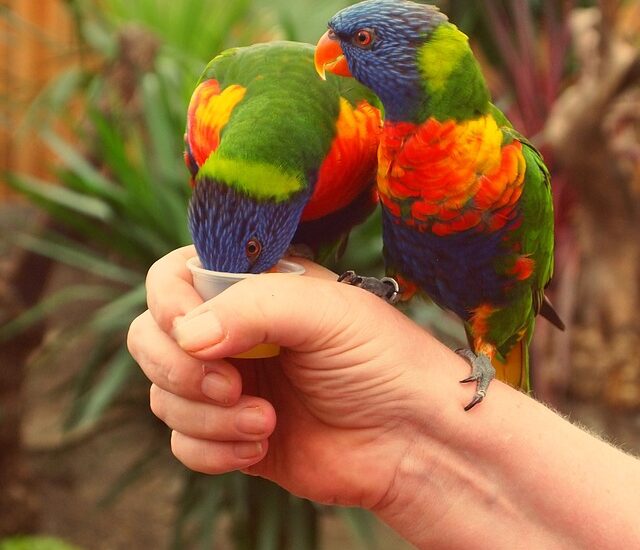When and how do finches lay eggs?
Finches are monogamous birds. By the start of the winter, both female and male finches start looking for their mates and by the time the breeding season comes, they have paired up to reproduce. Between March and August, finches breed. In one summer, a breeding pair may produce up to six clutches of eggs, although they can usually only raise three clutches.
Nests are shallow and cup-shaped and are built by the female. They’re fashioned out of hair, grasses, or other readily available fibers and can be found in bird boxes, tree cavities, buildings, shrubs, and tree branches. 3–6 blue or greenish-white eggs with black markings near the big end can be laid by the female finch. Each egg of a finch hatches in 13 to 14 days and weighs about 2.4 grams.
After the chicks hatch, the female finch conducts all of the incubation and broods them for a few days. Incubation takes anywhere from 12 to 16 days depending on the species. Because not all eggs in a nest hatch at the same time, wait a few days after the first hatchlings appear before deciding that the rest of the nest’s eggs aren’t viable.
How many eggs do finches lay at a time
A female finch’s reproductive tract can hold sperm for up to 16 days after mating. Between five and seven days after breeding, female finches lay an egg every day. The average clutch has three to six eggs, but the total number of eggs varies from three to eight. And yes ! don’t be alarmed if your female finch doesn’t sit on eggs immediately away; your finches’ egg can stay fertile for 6 days even without incubation. Many finches wait until all or nearly all of the eggs have been laid before sitting on them.
How to tell if a finch is going to lay eggs
A female finch will put on weight as she prepares to lay her eggs. When you lift her, you can observe that she’s heavier than before. Her stomach will grow in size and firmness. To replace the moisture required to hatch an egg, she will drink extra water. She’ll probably chew and shred other objects for her nest, as well. If you reach into your finches’ cage, she will likely get defensive, vocalizing and retreating away. Rather than perching on the perches, several varieties of birds including finches prefer to spend time on the cage floor. One more thing! Your pet’s droppings could get smellier and larger just before the egg hatches and a single clutch of zebra finches can contain up to eight eggs, with the average being three to six.
What are the symptoms of finches laying eggs
A finch will not display any prominent signs of laying an egg. She’ll simply lay one, and you won’t know about it till later. However, If the conduct you’re witnessing isn’t normal, it’s a sign that something isn’t right.
- Keep track of your finches’ activities and behavior daily.
- Don’t get the two mixed up,egg-laying isn’t the same as reproduction. Even if there is no male finch in the cage, female finches will often lay eggs.
- Keep an eye out for the mate.
Moreover, your finch could be carrying an egg she is unable to lay. Sitting with her legs apart, droppings sticking to her back end, appetite loss, fatigue, and straining are all signs that your Finch might be egg-bound. A finch’s puffiness indicates that she is not in good health. This is an emergency if you suspect she’s egg-bound. This situation can kill a bird in a matter of hours.
How to take care of finch eggs
Finches are jittery birds by nature. They don’t crave human company most of the time, but they dislike it even more during breeding and egg-laying season. You should keep an eye on your finches and their egg-laying behavior, but don’t annoy them physically. Because both female and male finches sit on their eggs, pay attention when you see one in the nest most often. Nest abandonment can be caused by counting the eggs in the nest when a finch is sitting on them.
You simply should not handle the eggs after they’ve been laid. Leave your finches alone with the youngsters and the new clutch of eggs. Just make sure they have enough food in their cage to feed their offspring. Allow your finches to build their nests and care for the eggs on their own.
How to tell if finch eggs are fertile
Remove all of the eggs from the nest. Shine a bright light on the egg. You’ll notice tiny small blood vessels if the egg is viable. You’ll notice a yolk if the egg isn’t fertile. There are no other options. Replacing the viable eggs in the nest is a good idea. The eggs will be returned to the female finch. In addition to sitting on the eggs, the male will assist. Both will provide food for the chicks.
Nonetheless, calcium is more important for female finches. Crush fine chicken eggshells in a grit cup and stir them in. Extra greens and diced hard-boiled eggs should be fed to the chicks once they hatch. Remove the nest for a bit after the chicks have left the nest and aren’t begging for nourishment. Female Zebra Finch usually continues laying eggs until she is completely exhausted.
Why do zebra finches bury their eggs
The egg-laying is normally done in the morning, and the egg is laid each day. In one summer, a finch pair may produce up to six clutches of eggs, although they can usually only raise three clutches. However, some zebra finches bury their eggs after laying them. There could be a variety of causes for this, but some of the most prevalent are:
- Because the female finch in a breeding pair may be frail, it is recommended that you add some hard-boiled eggs with yolks to the cage of your finch, as well as eggshells or cuttlefish bones.
- If the male and female finch are inexperienced, like during their first breeding cycle, they may bury the eggs; however, if an owner places the egg again after removing the finches from their nest for a short period, the female finch will sit and begin incubating the egg most probably.




